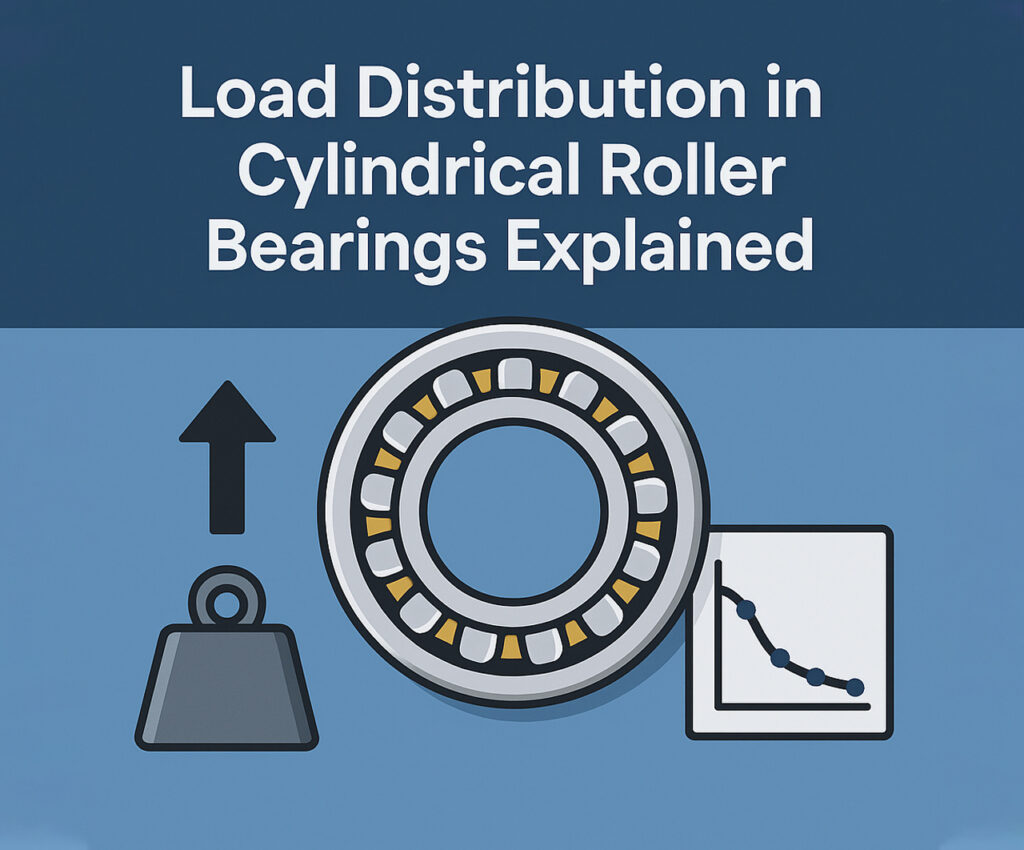In industrial machinery and high-performance systems, understanding radial cylindrical roller bearings, cylindrical roller thrust bearing, and cylindrical rollers is crucial. These bearings manage massive loads and demand precise engineering, especially when efficiency and durability are at stake. This article breaks down how load distribution works inside these essential components, offering insights that go beyond the basics and helping engineers and technicians optimize bearing performance. Know More
What Are Cylindrical Roller Bearings?
Cylindrical rollers are shaped to handle large radial loads efficiently. Unlike ball bearings, which make point contact, radial cylindrical roller bearings create line contact with the raceway. This line contact increases load capacity and reduces deformation. It’s what makes them ideal for gearboxes, motors, wind turbines, and large mechanical presses.
When axial loads come into play, a cylindrical roller thrust bearing becomes essential. This type is specifically designed to take on loads parallel to the shaft. They offer high rigidity and resistance to axial displacement, particularly in heavy-duty applications like rolling mills or vertical pumps.
The Basics of Load Distribution
Inside any bearing, load isn’t spread equally across all elements. With radial cylindrical roller bearings, the load is shared along the length of the rollers. However, edge loading can occur if there’s any misalignment. That means the ends of the rollers bear more stress, leading to uneven wear and potential early failure.
Proper load distribution ensures each cylindrical roller shares the work. The result: longer bearing life, less friction, and more consistent performance.
Misalignment: The Silent Load Killer
Misalignment throws off load distribution dramatically. Even a slight deviation in shaft or housing alignment can push certain cylindrical rollers to take on too much force. This can cause micro-spalling at the contact edges and accelerate fatigue.
The solution is two-fold:
- Use self-aligning features when possible.
- Ensure tight tolerances during installation.
Precision in housing and shaft machining directly influences how the radial cylindrical roller bearings distribute force.
Rigidity and Bearing Deflection
Every material deflects under load, including cylindrical rollers. However, the key is to keep deflection predictable and minimal. When a bearing’s stiffness matches the system’s overall rigidity, it maintains even load sharing.
Designers often use finite element analysis (FEA) to model how cylindrical roller thrust bearing and radial types will behave under different forces. Optimizing bearing placement and fit based on these simulations significantly improves overall system performance.
Number of Rollers and Load Spread
More rollers generally mean better load distribution. But packing too many cylindrical rollers into a bearing can increase internal friction and heat.
Engineers must balance:
- Roller count
- Size and diameter
- Raceway contact angle
For radial cylindrical roller bearings, a full complement design (no cage) can carry more load but at lower speeds. Caged designs operate more smoothly and are better for high-speed systems.
Temperature and Load Dynamics
Heat alters bearing clearances. As components expand thermally, the load on the inner cylindrical rollers may increase. A well-chosen clearance helps accommodate this, keeping load distribution within acceptable limits.
Lubrication also plays a role here. The right viscosity and flow prevent metal-to-metal contact, ensuring the radial cylindrical roller bearings maintain their line contact integrity.
For high-temperature applications, special materials and heat treatments on cylindrical roller thrust bearing types are often required.
Axial Load Factors
While radial cylindrical roller bearings focus on radial forces, many designs also experience axial components due to gear thrusts or angular misalignments. If the axial load becomes significant, a cylindrical roller thrust bearing must be added to the design.
Combining radial and axial units provides hybrid support, especially in applications like railway axles or vertical turbines.
Advanced Load Simulation
Modern software allows simulation of load behavior in real-time. Engineers can now model how cylindrical rollers respond under multi-directional loads, different shaft speeds, and varying temperature conditions.
These tools show exactly how loads move from one roller to another during dynamic operation, helping predict:
- Peak stress points
- Fatigue risk
- Ideal lubrication intervals
Leveraging this data leads to better design choices, reduced bearing failure, and extended service intervals.
Lubrication and Load Sharing
Without proper lubrication, load distribution becomes uneven. Friction rises, heat builds, and localized wear increases. The lubricant film between cylindrical rollers and the raceway needs to be thick enough to support the load without metal contact.
Grease is common for moderate-speed radial cylindrical roller bearings, but oil is often used in high-speed or high-temperature systems. For cylindrical roller thrust bearing units, oil circulation systems provide continuous cooling and protection.
Load Zones and Rotational Behavior
Load zones describe the areas of the bearing actively supporting force. In radial cylindrical roller bearings, this typically spans 120° to 180° of the circumference. The rest of the bearing is unloaded or lightly loaded.
For dynamically loaded systems, this zone rotates with the shaft. Load balancing features, like preloading or staggered dual bearings, help keep the force distribution symmetrical over time.
Real-World Application Tips
- Use precise fits: Match the bearing with correct shaft and housing tolerances.
- Avoid underload: Light loads can cause slippage and uneven wear.
- Check alignment often: Especially after initial running hours.
- Don’t over-lubricate: Too much grease increases internal resistance.
- Choose the right cage design: For optimal load sharing and speed compatibility.
Final Thoughts
Understanding load distribution in radial cylindrical roller bearings, cylindrical roller thrust bearing, and cylindrical rollers is key to building longer-lasting, more efficient mechanical systems. It’s not just about capacity—it’s about how that capacity is used across the contact surfaces.
By factoring in alignment, fit, temperature, lubrication, and simulation data, engineers can ensure that each cylindrical roller does its job efficiently. The result is smoother operation, lower maintenance costs, and better performance across the board.

